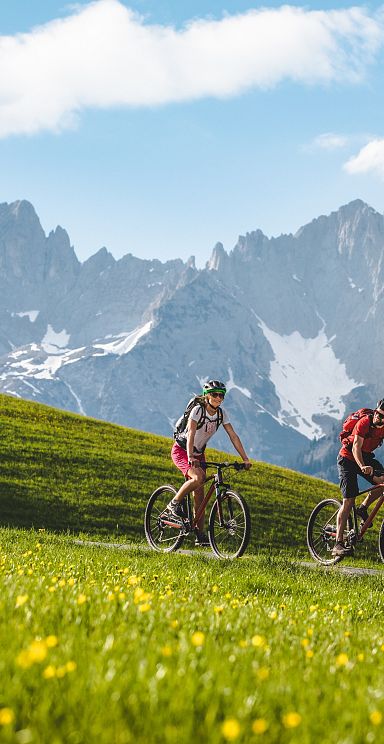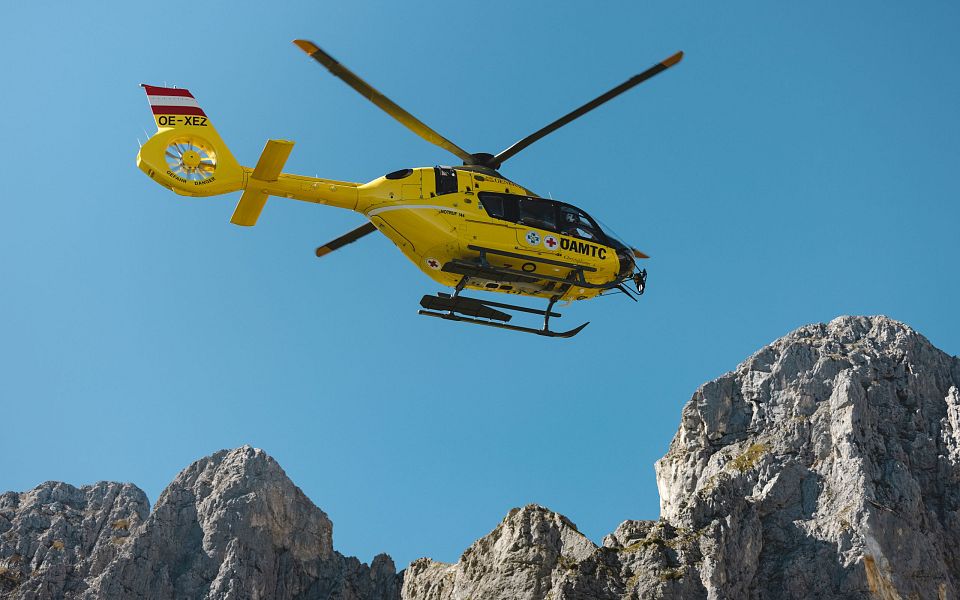Cycling SAFELY
Tips and advice for your safety when cycling
Alongside the cycling experience, safety is the top priority. The basics are adherence to important rules of behaviour as well as accurate tour planning and adequate equipment.
As a health and outdoor sport, cycling offers great opportunities for fitness, adventure and socialising. The following recommendations from the Alpine clubs serve to make cycling and mountain biking tours safer, nature-friendly and conflict-free.
Cycling and mountain biking are endurance sports that place positive demands on the heart, circulation and muscles. To benefit fully, you need good health and a realistic sense of your own capabilities. Avoid time pressure and increase the intensity and duration of your rides gradually.
Overestimating your strength and fitness can raise the risk of accidents and reduce the enjoyment of mountain biking. If you’re unfit, unwell or older, a sports medical check-up can help you better assess your limits. And remember: regular endurance and strength training significantly boosts both safety and enjoyment.
Specialist literature, maps, online resources and local experts are all valuable tools when choosing a bike tour that matches your fitness level and ability. Always tailor your route to suit the group, the weather forecast and current trail conditions. Lone riders should take extra care – even a minor incident can quickly become a serious emergency.
Keep a close eye on the weather, as rain, cold and heat can significantly increase the risk of accidents. Technical difficulty ratings are not standardised for mountain biking, so it’s best to start cautiously in unfamiliar terrain to ensure you have enough energy for any surprises along the way. When riding in a group, make sure all participants are physically and technically capable of completing the tour without being pushed beyond their limits.
Do not cycle cross-country to avoid erosion damage. Only use suitable roads and official cycle paths and respect local closures and regulations to avoid conflicts with landowners, path owners and other nature users.
Please note: Cycling in the forest (including forest roads and other forest paths) is generally prohibited. It is only permitted with the consent of the forest or forest road owners. Consent to ride bicycles or mountain bikes in the forest for the general public can be recognised by the signage.
Shortcuts and detours off the beaten track are prohibited and absolutely "uncool", as they destroy our nature experience.
Check the brakes, air pressure, tight fit of the wheels, suspension and gears of your bike before every ride. Annual maintenance by a specialist workshop ensures that your bike is in perfect technical condition. Make sure your riding position is healthy and ergonomic.
Warm clothing, rain and wind protection, a repair kit and a first aid kit all belong in your rucksack – along with a mobile phone (EU emergency number 112), a light, and enough food and drink. Gloves and goggles protect your hands and eyes. A map or GPS device is also a valuable aid for orientation.
Uphill and downhill, always wear a helmet! In the event of a fall or collision, a helmet can prevent head injuries or even save your life. Protectors can protect you from injury.
Make sure your helmet fits properly and check that it is fastened before every ride. Back protectors to prevent spinal injuries are usually already integrated into modern bike rucksacks. For more technically demanding trails, it is also advisable to wear knee and elbow pads. Remember that you are often travelling faster on a bike than in a car when descending forest tracks - but without a seatbelt and airbag!
Show consideration for pedestrians by announcing your arrival in good time and reducing your speed. Stop if necessary. A friendly greeting promotes acceptance. Ride in small bike groups and avoid paths that are heavily frequented by hikers. Be polite and respectful to others - a brief message about how many others are coming after you and a "Thank you!" are particularly good for your karma.
Adapt your speed to the situation at hand. Ride attentively and be ready to brake, as unexpected obstacles can be expected at any time. You can learn riding and braking techniques on mountain bike courses. Pedestrians and animals move slower than you, so always ride on sight. Bear in mind that the braking distance on loose, gravelly surfaces is longer and the braking process more difficult than you think.
By braking in a controlled manner so that the wheels do not lock, you prevent soil erosion and damage to the road. Take your rubbish with you and avoid noise. Sensitive braking is of course also relevant to safety. Experts teach the correct riding and trail-friendly braking technique in mountain bike courses. Packing your own rubbish is a matter of course, taking other people's rubbish down into the valley is particularly exemplary.
Dogs
Please use the dog waste bags along the cycle paths to avoid soiling the pasture areas and nature. Help to keep the countryside clean. To avoid problems with pedestrians - please keep dogs on a lead!
The twilight phase is the time for wild animals to feed. Therefore, drive in daylight to avoid disturbances. Approach animals at walking pace and close pasture fences after driving through them. Avoid fast and hasty movements. Behave quietly in the forest and do not make unnecessary noise.


Riding technique course: Söller Bike Saloon
In the Söller Bike Saloon you have the opportunity to prepare perfectly for the open terrain. The pump track and the two beginner trails help to improve your technique and increase your riding safety. Entry is free of charge.

Cycling in the Wilder Kaiser region







Difficulty classifications
A family-friendly cycle path or MTB route that can generally be ridden on standard bikes, with a predominantly well-maintained surface such as fine gravel, asphalt or similar. Slopes and gradients rarely exceed 5%, with a maximum of 15% on short sections. The route features a mix of gentle ascents and descents and follows paths with little or no motor vehicle traffic.
As a rule, there are no particular danger spots – and where these do exist, they are clearly marked (e.g. with signage). Some sections also serve as agricultural or forestry roads, so occasional obstructions from commercial traffic (e.g. lorries, tractors, parked vehicles, muddy or dirty roads) should be expected in these areas. In some cases, short-term closures may be necessary for operational reasons. Due to the alpine terrain, unmarked hazards may also arise as a result of natural events.
Requires confident cycling skills and a particularly cautious, defensive riding style. Mountain bike equipment is recommended. Gradients generally range between 5% and 12%, with short sections reaching up to a maximum of 17%. The route includes winding and sometimes unclear sections. Motor vehicle traffic using the full width of the trail must be expected.
Infrastructure along the route – including the road surface, drainage systems (e.g. water channels), barriers (e.g. gates), safety measures (e.g. absence of railings or fencing), and warning signs – is designed exclusively for commercial traffic involving tractors and lorries. These features may themselves pose hazards for cyclists.
Operational disruptions such as temporary closures (e.g. due to logging or timber transport), stored goods or equipment, parked machinery, and danger spots caused by natural events are to be expected at any time. Steep slopes adjacent to the route are unsecured.
MTB route with numerous potential hazards, exceeding the maximum gradients and difficulty level of red routes. The terrain is significantly more challenging throughout. Full mountain bike equipment is mandatory. Riders must cycle with full awareness and adjust their riding to suit the conditions at all times.
Cycle guidance systems
All official cycle paths and mountain bike routes are signposted in accordance with Tyrolean regulations. The signs shown below indicate the correct route on official cycle paths and MTB trails (including wide forest roads, alpine tracks and service roads), helping you stay oriented. It is the sole responsibility of each individual to assess whether it is safe to cycle.
Cycle paths and leisure routes in the valley are marked with green signs, while official mountain bike routes are signposted with dark blue signs.

